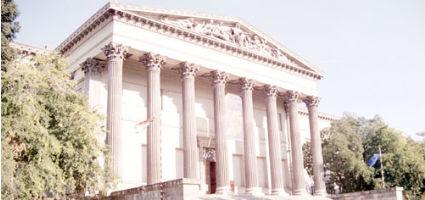2025. May 11. Sunday
Hungarian National Museum - Budapest
 |
Address: 1088, Budapest Múzeum körút 14-16.
Phone number: (1) 338-2122
E-mail: info@hnm.hu
Opening hours: Tue-Sun 10-18
|
The exhibition has closed for visitors.
2012.01.18. - 2012.02.12.
Museum tickets, service costs:
|
Ticket for adults
|
1100 HUF
|
|
|
Ticket for students
|
550 HUF
|
|
|
Ticket for soldiers
|
550 HUF
|
|
|
Ticket for pensioners
|
550 HUF
|
|
|
Ticket for families
(2 adults + children)
|
1150 HUF
|
/ family
|
|
Individual guide
|
400 HUF
|
/ capita
|
|
Group guide
(max. 5 people)
|
1800 HUF
|
/ group
|
|
Group guide
(11-15 people)
|
6000 HUF
|
/ group
|
|
Group guide
(max. 15 people)
|
5500 HUF
|
/ group
|
|
Group guide
(16-25 people)
|
9700 HUF
|
/ group
|
|
Group guide
(1-5 people)
|
1500 HUF
|
/ capita
|
|
Group guide
(6-10 people)
|
13000 HUF
|
/ group
|
|
Group guide
(11-15 people)
|
16000 HUF
|
/ group
|
|
Group guide
(16-25 people)
|
24000 HUF
|
/ group
|
|
Group guide for students
(max. 25 people)
|
4500 HUF
|
/ group
|
|
Group guide for students
(max. 15 people)
|
6000 HUF
|
/ group
|
|
Group guide for students
(max. 25 people)
|
12000 HUF
|
/ group
|
Raoul Wallenberg was last seen accompanied by three Soviet soldiers on 17 January 1945. 'I do not know if I am a quest or a captive' - he said, before he said good by.

After the German occupation of Hungary, news spread about the horrible fate of the Jews in Hungary. Raoul Wallenberg was asked by the Swedish Minister of Foreign Affairs, the ambassador of the USA in Stockholm, the governmental organization, the War Refugee Board for to set up the rescue of refugees. Raoul Wallenberg often visited Budapest as he worked for the export-import company managed by the Hungarian businessman Kálmán Lauer. This is how he became a second secretary for the Swedish Embassy.
Raoul Wallenberg fought for saving human lives with way more interest than it was usual. He managed to get everywhere where his help was needed. His self-confidence and personality made magic and made his enemies forgot that he was just as defenceless as his patrons. According to the report of the Swedish humanitarian action dating back to 16 January 1945, Sweden protected nearly fifty buildings and eight-thousand people. During his rescue activities, Raoul Wallenberg did not forget about the times after the war and worked out plans for the economy after the war. He was preparing for a meeting on these, when he was last sawn by his colleagues on 17 January, 1945.
Raoul Wallenberg is one of the most well known Swedish diplomats in the world. The 100th anniversary of his death is commemorated both in Hungary and Sweden.
On 17 January 2012, the Swedish Institute of Stockholm organized the exhibition on display at the Hungarian National Museum. The exhibition that focuses on tolerance, civil rights and responsibility is to be shown in Budapest first, but will travel on to Moscow, Berlin, Tel Aviv, Washington DC, New York and Toronto.
Part of the material is an informatics solution by which we hope to aid the visually impaired to understand more of the exhibition. By realising augmented reality in the museum frameworks, we invite the visitors to meet Raoul Wallenberg, or at least his visual outline.

After the German occupation of Hungary, news spread about the horrible fate of the Jews in Hungary. Raoul Wallenberg was asked by the Swedish Minister of Foreign Affairs, the ambassador of the USA in Stockholm, the governmental organization, the War Refugee Board for to set up the rescue of refugees. Raoul Wallenberg often visited Budapest as he worked for the export-import company managed by the Hungarian businessman Kálmán Lauer. This is how he became a second secretary for the Swedish Embassy.
Raoul Wallenberg fought for saving human lives with way more interest than it was usual. He managed to get everywhere where his help was needed. His self-confidence and personality made magic and made his enemies forgot that he was just as defenceless as his patrons. According to the report of the Swedish humanitarian action dating back to 16 January 1945, Sweden protected nearly fifty buildings and eight-thousand people. During his rescue activities, Raoul Wallenberg did not forget about the times after the war and worked out plans for the economy after the war. He was preparing for a meeting on these, when he was last sawn by his colleagues on 17 January, 1945.
Raoul Wallenberg is one of the most well known Swedish diplomats in the world. The 100th anniversary of his death is commemorated both in Hungary and Sweden.
On 17 January 2012, the Swedish Institute of Stockholm organized the exhibition on display at the Hungarian National Museum. The exhibition that focuses on tolerance, civil rights and responsibility is to be shown in Budapest first, but will travel on to Moscow, Berlin, Tel Aviv, Washington DC, New York and Toronto.
Part of the material is an informatics solution by which we hope to aid the visually impaired to understand more of the exhibition. By realising augmented reality in the museum frameworks, we invite the visitors to meet Raoul Wallenberg, or at least his visual outline.
